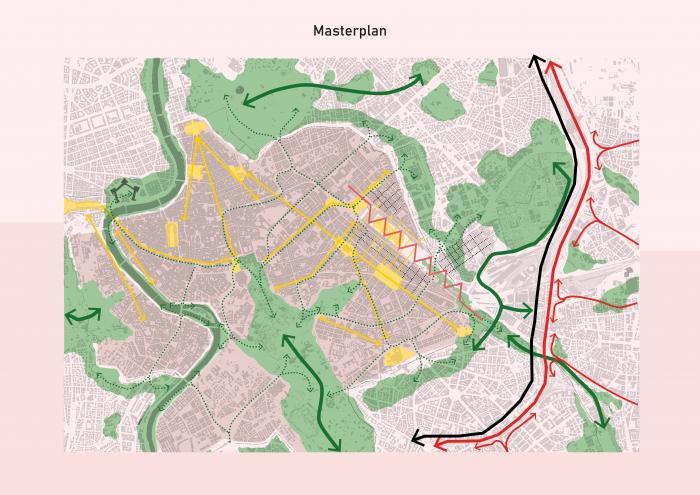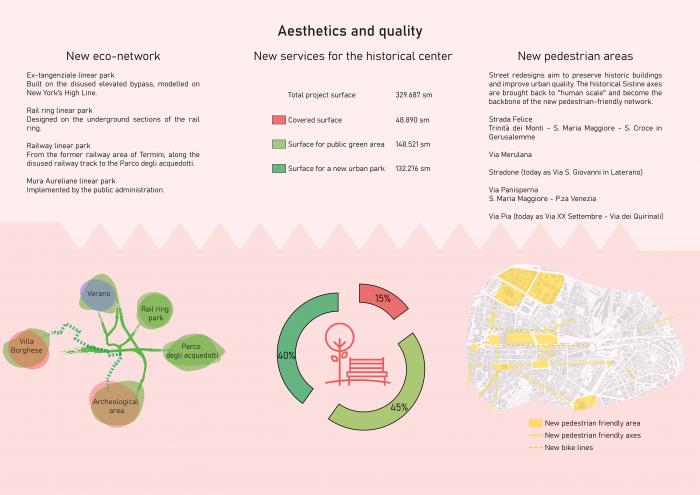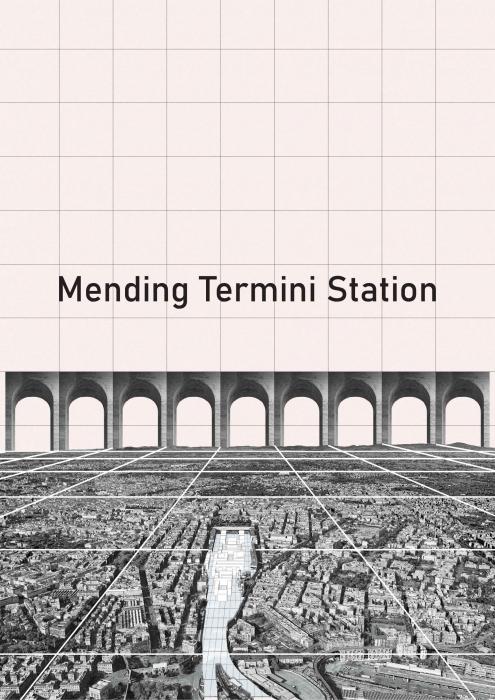I. SUMMARY INFORMATION
Project
269902
Status
Submitted
Award category
Preserved and transformed cultural heritage
You want to submit
NEW EUROPEAN BAUHAUS RISING STARS : concepts or ideas submitted by young talents (aged 30 or less)
Project title
Mending Termini Station
Full concept/idea title
Railway yards and urban transformations: Mending Termini Station
Description
Mending Termini Station is a utopian but possible Rome, a multicentric and interconnected, sustainable and inclusive city. It is the definition of a method able to manage and direct urban transformation, putting together interventions that too often are spread over the city without having a chance to resonate together. It is the need for a strategic planning as the only possible way to design the sustainable development of the city as a complex organism.
Where is your concept/idea being developed or intended to be implemented in the EU?
Italy
Roma
Piazza dei Cinquecento, 1
41°54’03,67” N
12°30’06,29” E
Rome
00185
II. DESCRIPTION OF THE PROJECT
Please provide a summary of your concept/ idea
The role of Termini Station in Rome's transport system has led to various proposals for relocation since it was first built. The most interesting of these were the 1931 Master Plan which proposed a railway ring and an underground railway link, the definition of a new form of mobility and the maintenance of the central station at Termini underground, transforming the area into a new urban centrality. The project was not approved, but some of the proposals are still current: the 1965 Plan proposes the closing of the railway loop, confirmed by the current 2008 Master Plan.
The current closing of the ring allows the definition of a new urban and metropolitan mobility scenario, integrated between railways and surface transport, not centralised, but tangential, in which an underground high-speed railway link would remove congestion from the historic centre and at the same time preserve Termini as the gateway to the capital. The urbanization of the railway area and the refunctionalization of the station buildings would make it possible to mend the urban fracture and start a process of regeneration of the entire central area.
A new sustainable, inclusive and efficient neighbourhood could be built in an area next to the historic centre of Rome and in parallel could allow concomitant valorisation and recovery of the whole area within the Aurelian Walls (UNESCO heritage). The lack of services and nature in the historic city can be compensated by the new urbanisation and the reorganisation of metropolitan mobility can allow the progressive abandonment of private transport in the central area. The resulting increase in public space would allow the redesign of a future Rome in which urban and environmental quality, sustainability, identity and inclusion are concrete qualities. This project is a “realizable utopia”, a methodology of intervention that looks to distant targets, allowing us to have the necessary perspective to make the first step.
Please give information about the key objectives of your concept/idea in terms of sustainability and how these would be met
Rome is at the top of the European rankings for private vehicle use: the resulting traffic, pollution and degradation are unsustainable from several points of view. The scenario envisages a new sustainable model of mobility, adequately interconnected and promoting the gradual elimination of private transport.
The project links the closure of the railway Ring to the infrastructural interventions present in the Master Plans (e.g. Rome Metro) and redesigns a mobility model, integrated between railways and surface transport, no longer centralised but tangential. Trains of local and regional lines circulate on the Ring providing also a metropolitan transport service. The stations become intermodal interconnection nodes with other public transport systems, both rail and road, which are responsible for cross-connection (existing and planned metro, tram and trolleybus lines and main metropolitan road networks). The high-speed line travels separately on an underground North-South link (taken from the 1931 Master Plan) with a single stop at the new Termini Underground Station, guaranteeing the maximum speed offered by the network and improving connection on the national scale. The historic and iconic building of Termini Station is preserved as the "gateway" to the capital, while the entire central area is decongested by the concentrated influx of commuters.
The disused railway area (39 hectares) and the new public and private functions contained in the station buildings make it possible to define a programme of interventions aimed at mending the urban fracture and starting a regeneration process extended to the entire central area. The new regulation of the Limited Traffic Zone (LTZ), the integration of the trolley-tram network and the reorganization of the main roads allow the creation of an interconnected ecological network that favours sustainable transport and soft mobility.
Please give information about the key objectives of your concept/idea in terms of aesthetics and quality of experience beyond functionality and how these would be met
The reorganisation of infrastructure and transport opens up the possibility of intervening to improve the quality of the central area. The reduced presence of cars generates an increase of spaces to be reshaped according to new needs: the renaissance and nineteenth-century roads are redeveloped as green avenues, integrating new trees and urban vegetation. The intervention on the public space participates in the process of optimisation of urban quality not only at a spatial and perceptive level, but also at a climatic and environmental level (reduction of the urban heat island effect and of impermeable surfaces), and proves to be a priority to generate an effect capable of extending the requalification process to entire areas.
Therefore, the next step proposed by the project is a series of targeted interventions for the recovery and revalorisation of degraded areas and buildings, linked to more general maintenance and restoration interventions on facades and urban backdrops.
The intervention on Termini Station and its railway area, the project mends the urban fracture by increasing the facilities in the central area and diversifying the housing offer. The planned neighbourhood is developed in continuity with the surrounding city: buildings and public spaces are designed to recreate areas in harmony with the human dimension, to connect with the context and to create views and perspectives that give the project its own identity and recognition. The underground high-speed station rises up to an underground square at the heart of the new metropolitan hub. The station building is redeveloped as an emblem of Italian futurist and rationalist architecture, incorporating executive, commercial and public functions.
New facilities and public spaces (squares, streets, green spaces and urban parks) guarantee urban standards for the future inhabitants of the area, but at the same time increase the facilities for the inhabitants of the historic centre and neighbouring districts.
Please give information about the key objectives of your concept/idea in terms of inclusion and how these would be been met
The Mastersplan proposes a strategic planning towards a multicentric, interconnected and sustainable city, consisting in a development process that foresees inclusion as a fundamental step of the different scales of intervention. Public administration, public and private companies, citizens (social and professional associations) and academia (University and Research) should be included in a co-planning process in order to achieve macro-objectives more successfully.
The reorganisation of the infrastructural system, the underground high-speed railway link and the new urbanisation of the Termini railway site are possible through a Programme Agreement between the Public Authorities and Rete Ferroviaria Italiana (the infrastructure operator) which provides for a " do ut des " negotiation. Also in the context of the new district, the distinction between public and private areas has been determined by the calculation of the percentages of services and green areas needed by the whole surrounding area and the profit margins that RFI could obtain.
At the same time, the need for citizens to be included in a participatory planning process for the new urban area is fundamental to creating a neighbourhood that meets needs and ensures the development of an identity and sense of belonging. The process can be implemented by applying the example of international case studies, in which - starting from the planning stages - inclusion was achieved through advertising and social campaigns, improved through surveys and periodic open-door meetings in which to discuss the project, up to the organisation of workshops in which citizens themselves (assisted by technicians and universities) took part in the design of spaces and street furniture.
Please explain the innovative character of your concept/ idea
The Mending Termini Station project promotes a methodological and perceptive innovation based on the resonance of the actions that can be implemented in an urban context. In fact, individual actions - however radical and effective they may be - do not have the power to homogeneously resolve the problems of the entire city and change its perception. Strategic planning responds to these needs by foreseeing a precise sequentiality in the development phases starting from a structuring project. Once the final objective and the methods of implementation have been determined, all existing or planned urban projects can be incorporated into the planning process. Step by step new interventions are carried out at more and more specific levels implementing the multi-scalar transformation.
Strategic planning is therefore a long-term process that sets goals that are desirable but impossible to achieve at the time it is developed. The perceptive innovation of Mending Termini Station is based on a concept of utopia aimed at imagining the consequences of our actions on the city, trying to understand the processes through which a result can be achieved. Through the perception of the utopian city (polycentric, sustainable and inclusive) it is therefore possible to stimulate the vision of a possible development. By increasing the debate on possible scenarios for the city's evolution, the involvement of stakeholders is encouraged and change is accelerated.
The innovation of the Mending Termini Station project lies precisely in the combination between utopian images and strategic planning, two worlds apparently distant from each other but able to reach a shared and homogeneous result, restoring a city in dialogue with all its parts but irrevocably transformed.
Please detail the plans you have for the further development, promotion and/or implementation of your concept/idea, with a particular attention to the initiatives to be taken before May 2022
In the Mending Termini Station project the priority interventions on the infrastructural system and mobility offer a plausible transformation perspective, spread over time. We can therefore distinguish two scenarios: a short-term one, necessary to set up the participatory dynamics and the debate on the project; a long-term one, able to propose this methodology in the following phases.
The aim of the short-term scenario, hopefully within a year, is to bring Mending Termini Station to the attention of Roma Capitale, Rete Ferroviaria Italiana and the Citizens, including the Universities. By sharing the description of the project through crowdfunding systems, social networks, blogs and the development of a shared platform (accessible to anyone), public interest could be measured, collecting comments and stimulating the perception of change. Once a pre-determined level of interest had been reached, the proposal could be sponsored to Roma Capitale and RFI, which would have enough material available to assess the validity of the initiative. As a result of the debate - at the end of next year - a round table could be set up where representatives of the various categories could discuss the implementation of the project.
In the long-term scenario the achievement of this goal would mark the milestone to start a strategic planning, articulated on the Mending Termini Station proposal. Each phase of development could follow the format set in the first year to ensure greater inclusiveness, participation and quality in the interventions. By guiding development in this direction, new possibilities would resonate with each other, feeding the already existing dynamics of participation and sharing, making the possible transformation of a utopian city a reality.
III. UPLOAD PICTURES
IV. VALIDATION
By ticking this box, you declare that all the information provided in this form is factually correct, that the proposed concept/idea has not been proposed for the New European Bauhaus Rising Stars Awards more than once in the same category.
Yes








